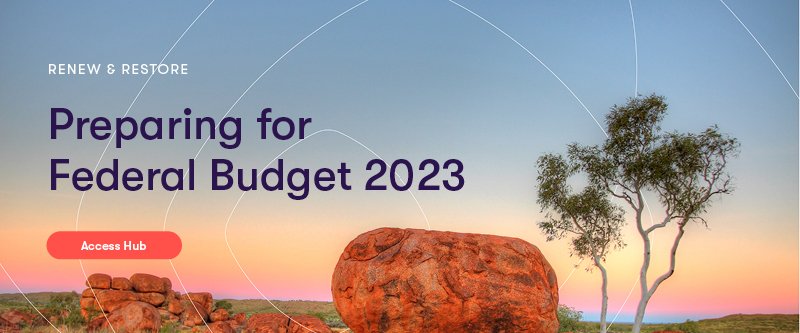Rebecca Archer
Welcome to Navigating the New Normal – Grant Thornton’s podcast exploring trends in business and the marketplace.
I’m Rebecca Archer and today I am excited to bring you another Federal Budget edition of our series. Today we’ll hear from ABC Journalist Karina Carvalho, Chief Economist Besa Deda, and Grant Thornton Partner Paul Gooley at our virtual seminar as they discuss Labor’s Budget spending and if Australian businesses will continue to feel the pinch or whether we can bypass a recession.
So, what was announced in the Budget and how will spending allocations alleviate or build pressure for Australian businesses?
Karina Carvalho
I want to begin by acknowledging the Gadigal of the Eora Nation – the traditional custodians of this land – and pay my respects to the elders both past and present. I also acknowledge the traditional custodians of the various lands on which you all work today, and the Aboriginal and Torres Strait Islander people participating in this seminar.
Now we will have time for audience questions later in the session, but feel free to add your questions in as we go. You can submit questions via the Q&A panel on your screen. If your question doesn't get asked during this seminar and we will get back to you via email. You'll also find this webinar platform allows you to customize your screen. So, feel free to move or change the size of any of the windows you see in front of you.
As I said, I'm Karina Carvalho – a presenter with ABC News for the last 15 years – so I've hosted my fair share of post-Budget events.
I'd like to introduce our panel – Besa Deda is the Chief Economist of St. George Bank, Westpac Business Bank, Bank of Melbourne, Bank BA and BT – businesses within the Westpac group. Besa was appointed the Chief Economist of St. George Bank in 2008 – a role which saw her become the first female Chief Economist of a bank in Australia. Besa was subsequently appointed as a Chief Economist with Westpac Group in 2009, and is a key spokesperson on the economy and financial markets, managing a team of economists.
Paul Gooley leads Grant Thornton's National Corporate Finance practice and is Head of the Financial Advisory team in Sydney, specialising in advising clients on mergers and acquisition, fundraising and divestment across a range of industries and markets. We will hear from Besa and Paul shortly, but let's take a closer look at treasurer Jim Chalmers second Budget.
Up until the weekend, very few people thought it would deliver a surplus – but here we are. The first Budget surplus in 15 years and while it's small at four million dollars, it's an achievement previous Governments have promised and not delivered. Jim Chalmers is the first Labor Treasurer to announce a Budget surplus since Paul Keating in 1989. So, what does it mean and will it last?
The government has had to perform a delicate balancing act of providing cost of living relief to those doing it tough while not adding to inflation which remains stubbornly high. This second Chalmers Budget is more ambitious than his first mini Budget in October, which took a traditional soft approach and had few surprises in it.
The Treasurer's surplus has been achieved by a commodities windfall but also increased tax revenue thanks to a strong Labour market and record low unemployment.
Jim Chalmers and his Finance Minister Katy Gallagher have also pointed to $17.8b dollars in ‘savings and reprioritisations’ taking money from one department, like defence, and spending it somewhere else. They did this in October too – with savings worth $22b. The Government says debt will be almost $300b lower by the end of the medium term, saving some $83b in interest costs between now and 2035. But the Interest Bill is still $60m a day – it’s one of the fastest growing pressures on the Budget, and costs more than the family tax benefit, childcare or infrastructure.
So, a surplus this year but a structural deficit and rising debt to linger for years to come.
It's hard to ignore some of the social spending in this budget after rejecting calls for jobseeker to be increased substantially across the board, which was a measure recommended by the Government's own, handpicked expert committee, the Treasurer hinted at an increase for those over 55 to address the growing cohort of women who find themselves unemployed at that age.
But we saw last night, an overall increase in jobseeker by $40 a fortnight, which is less than the $50 a fortnight the Morrison Government announced in 2021. Oh, and the higher rate for older people will kick in at the age of 55, rather than 60.
Beyond that is the single parent payment being lifted to age 14, energy relief of $500 for more than five million households on Government payments, a rise in rent assistance of 15 per cent, and tripling g-p incentives for bulk billing in a cost-of-living relief package worth $14.6b.
Aged care workers will receive a 15 per cent pay rise in a bid to attract and retain staff in the growing sector, while the government has a trickier job of trying to reign in spending from the national disability insurance scheme, which will cost state and Federal Government $40b next financial year – and is projected to grow more than 10 per cent over the next decade.
The Government has stated the current growth of the scheme is not sustainable and will implement a growth target of eight per cent in the coming years. But besides the government's interest bill on debt, the NDIS remains the fastest growing expenditure item in the Budget. The Treasurer says the spending is modest but meaningful, and the Government wasn't more generous in areas like jobseeker simply because it can't afford it. So where is the money coming from?
Apart from the savings and ‘reprioritisations’ we can thank migration and record low unemployment. While you might have thought the RBA lifting the cash rate by 375 basis points in one year would have an impact on the workforce… it hasn't… well not yet anyway.
High migration has helped business meet the skills shortage left by COVID border closures and added to Government coffers in the form of income tax revenue. But the rate of arrivals has also put immense strain on housing supply in Australia's biggest cities of Sydney and Melbourne. Rents have exploded, adding to inflation, while the forecast drop in house prices has failed to materialise. Migration poses both an opportunity and a challenge for the government.
Then there is capitalising on the surge in commodity prices… the government wants to change the petroleum resource rent tax … a levy on Australia’s off-shore oil and gas projects, which don't pay royalties and can avoid paying the tax entirely by deducting their capital costs from 100 per cent of their project income. Under the proposal gas companies would only be able to claim against 90 per cent of their income allowing the Government to bring in an additional $2.4b over the next four years. Is it too much or too little? It depends on who you ask, but the industry itself is supportive of the change.
One of the other lingering questions from the budget is what the government will do with the already legislated stage three tax cuts introduced by the previous Government and supported by this one.
You won't find the numbers in the Budget papers, but they return $69b over four years to workers – the majority of which to those on six figure salaries. But as economic conditions become more challenging can Australia afford tax cuts for those on higher incomes set to come into effect on July 1 next year.
Well, at that point, it's probably good to bring in Besa Deda, the Chief Economist at St. George Bank. Besa, how significant is this surplus?
Besa Deda
Well, I think if we go back to the gloomy days of 2021 – back then we were anticipating, the Government was anticipating a deficit of nearly 100 billion for 22/23. We've seen a very sharp turn around. Yes, it's wafer thin, but it's a surplus, and the first surplus in 15 years, and really set up, I guess, more resilience for the Budget’s bottom line, and then resilience to any possible future shocks and also enabled, I think, the Government to deliver on helping households that are more vulnerable and need help from the high cost of living expenses.
Karina Carvalho
Yeah, the Treasurer Jim Chalmers was keen to play down the commodities windfall element and instead highlight the strong labour market and higher wages growth – is that accurate?
Besa Deda
Well, I think it's a combination of factors that have really helped deliver that surplus. It is the lower than anticipated unemployment rate. We've got a very low unemployment rate by historical standards of 3.5 per cent. It is the fact that we've got a very sharp recovery in net overseas migration, and migrants don't access social welfare payments, but they do pay income tax which helps deliver revenue increases to the Government. Commodity prices as part of the story the estimates were quite conservative and that
Besa Deda
has been a trend over recent years and therefore setting up a bit of a hollow log situation if you do have higher commodity prices, and then of course, you've got high wages growth. And you put that all together, and you've got a stronger nominal economy delivering higher tax revenues that helps the Government improve its bottom line – and that's exactly what's happened.
Karina Carvalho
So, the big question that a lot of economists are asking, or trying to answer rather, the morning after the Budget is whether these spending commitments are going to be inflationary or not?
Besa Deda
That is the $64 question, but of course, it's always going to be a very tough Budget for Jim Chalmers in terms of the way he frames it. On the one hand, he did need to help those households that are vulnerable and really suffering from higher cost of living. But then on the other hand, he really had to be very careful and targeted with that spending, because he doesn't want to be in a situation where you're stoking inflationary pressures, and possibly increasing the risk of rate rises from the RBA.
So very difficult and challenging for the Government to frame and balance those two challenges. Now, they did deliver on $20b of spending, 12b in 23/24. That is quite significant. And really, you can't have a situation where there's more spending, even though you can't begrudge that spending going to vulnerable households, and a situation where there's downward pressure on inflation – the two are quite incompatible. So, it does, I guess, raise the risk of extra household spending, or spending growth being fostered. And therefore, it also does potentially foster greater inflationary pressures, and could mean that rates have to rise again.
But whether the Reserve Bank delivers another rate rise won't come down to just the Federal Budget, it will come down to a range of factors. They're focusing very closely on incoming data, both domestically and offshore, and it'll be collectively what sort of picture does that paint in terms of inflation going forward?
Karina Carvalho
I do want to come to the RBA response in a moment. But if we stick with some of these spending elements in the Budget, the Treasurer was adamant that the Budget will not add to inflation, saying that the energy relief in particular will help as well as the lower than expected power price rises. But if you have something like 5 million households with an extra $500 in their pockets, is that not going to add to demand?
Besa Deda
It will contribute to demand – that’s right, Karina. If you've got extra money in your hip pocket, particularly low income households that have a greater propensity, I guess, to spend that money rather than then save, that will foster an increase in demand, and that could mean stronger economic activity than otherwise would be the case – and it could mean stronger inflationary pressures.
Karina Carvalho
Talk to us about the intersection of fiscal and monetary policy here – is this Budget going to help or hinder the Reserve Bank to get inflation back to that 2-3 per cent band?
Besa Deda
Look, the Reserve Bank doesn't expect inflation to move back to that band until the middle of 2025, and that's broadly consistent with what the Government has printed last night, in terms of when inflation returns to target. Inflation is elevated…
Karina Carvalho
Is it? In the Federal Government's Budget, isn't June 2024? It's about 3.25 per cent.
Besa Deda
Yes, well, 3.25 per cent is still just a bit above the target band, but I guess the point is that inflation remains quite elevated, still well above the inflation target band of the RBAs, which is 2-3 per cent. Inflation did peak in – well we think it peaked in the last quarter of last year – and it is moderating, but there's still a way to go. There's still risk around those inflation forecasts, and therefore, even though our view is that the Reserve Bank won't be raising rates further in this cycle, you can't fully rule out that another rate hike might not be in the winds.
There's certainly signs that household spending growth is slowing. Population growth is helping keep household spending more resilient than otherwise would be the case. Particularly when household spending per capita – we can see evidence of that. There is a slowing underway, but there is that challenge of bringing inflation back into the band. I liken it to the fact that my seven-year-old squeezed toothpaste out of the tube – once it's out of the tube, it's pretty hard to get it back in, and that's the tricky challenge for the Reserve Bank.
Karina Carvalho
Yeah, what are some of the other factors that you said it will be considering when it looks at raising interest rates?
Besa Deda
The Reserve Bank will consider obviously household spending growth – that is the engine room of the economy – we are seeing signs of a slowdown in that space. They will look at the strength of the labour market. Now unemployment rates incredibly low at 3.5 per cent, but there are signs that unemployment will start to rise particularly if we look at forward looking indicators – there’s more applicants per vacancies; job ads are starting to come down. So, there are some signs that unemployment is starting to lift, but that obviously feeds into wages growth, which feeds into the inflation story – they’ll be looking at inflation expectations. The Reserve Bank is very keen to ensure that inflation expectations don't de-anchor, because then it will make its job a lot harder of bringing down inflation. It will also look at global factors, what other major central banks around the world are doing – that can have an influence on our currency, our currency then impacts the prices of imported goods and services, but also how our businesses compete in Australia.
So, there's a wide range of factors that the RBA will really be looking at. On balance, we think they're done, but like I said, we can't rule out another rate hike. I think at the margin, this does increase inflation pressures, or this budget does increase inflation pressures. But it's got to be considered against a whole wide range of factors.
The other point to just keep in mind is that there is a high share of housing loans that are at fixed rates that are due to expire this, in fact, there's 880,000 of them. And they will be expiring onto a high variable mortgage rate, which will have an impact on household spending growth. And then you've also got that situation where rents are also growing quite rapidly, and that's partly also due to the fact that population growth is recovering very rapidly. And there's a shortage of housing, and not much in the pipeline coming forward, given that building approvals are well off their peaks. And even in the Government's own forecasts last night, dwelling investment is set to decline for three straight years. So, the challenges around housing are only set to grow.
Karina Carvalho
Yeah, how is migration playing into the budget bottom line?
Besa Deda
So, I think of it in terms of the good, the bad, and the ugly. So, the good is that net international migration has really provided an injection of labour supply that was desperately needed by businesses in Australia. You know, unemployment is still well below the rate of unemployment that's consistent with full employment, there’s still skilled shortages, but that recovery in population growth and that recovery, that's net overseas migration, is helping address those stresses in the labour market that also have been contributing to wage increases in certain industries. And more broadly, in some other pockets. You know, the bad is that these people need somewhere to live, they need to buy goods and services, they need to fill out their homes with green goods, white goods, and so does make economic activity more resilient than otherwise would be the case, in an environment where the central bank is trying to slow economic activity in order to try and bring inflation back down to the target band.
And the ugly bit, I guess, is the fact that we do have a shortage of housing Australia-wide, and in some parts of Australia, it's quite acute. If we have a look at approvals to build those dwellings, 46 per cent of the recent peak – builders and developers still have elevated material costs, they've still got elevated labour costs, some of these builders and developers have gone bankrupt. So, you know, there's not a lot of projects in the pipeline that will add to that supply very quickly, and so in an environment where you've got net international migration ramping up very rapidly, and a shortage of housing, then that's really a recipe for some price responses. And so, we have seen dwelling prices stabilise around the bottom – they don't appear to continue to be declining, and in fact, we might even get a very modest upturn before rate cuts commence, which is unusual, and we're seeing very strong rental growth. So, 10 per cent last year, we think will be another 12 per cent per annum nationally this year.
Now, the Budget papers really stood out, I think in terms of the numbers for net overseas migration for 2022/23 – that’s 400,000 and that's a significant upgrade from 265,000 for the current financial year, that was forecast in just October of last year. And then if we have a look at the numbers going forward, they're also very elevated – you’ve got 315,000 for next financial year, and then 260,000 for the next few years. So very strong levels of net overseas migration are expected to be maintained.
Karina Carvalho
So, is there anything beyond rent assistance in the Budget to address housing supply and affordability?
Besa Deda
Look, there are some measures – the Rent to Build incentives was certainly a step in the right direction. There's also giving capital to the National Housing and Finance Investment Corporation – that’s another step in the right direction. But in terms of big measures to address the challenges that we face in housing in the near term, you know, there wasn't a significant amount there, and it is really difficult to address those challenges in the short term. It takes time to address housing supply, and it's, you know, it has many elements to it.
Karina Carvalho
Another one of the big spending areas is the NDIS. The Government will outlay $733m on eight measures designed to improve decision making at the NDIA, which is the agency that administers the scheme. Could the Government have revealed more detail about how it intends to make the scheme more sustainable? I understand that there's a review that's scheduled to come out in October.
Besa Deda
Yeah, the detail around the NDIS cap of 8 per cent, being introduced from 2026 was pretty light on the detail. NDIS is the fastest growing expenditure area for the Government. It's certainly a big issue over the longer term, and in terms of also addressing structural Budget issues for the government. So, it would be good to see more detail on that front, particularly given the challenges that Government will have around NDIS, and also growing pressures from the growth, the ageing of the population, and aged care more generally.
Karina Carvalho
The Economist John Quiggin, a professor at The University of Queensland, wants the axing of the stage three tax cuts taken to the next election. His argument is the opposition is weak at the moment and having the tax cut for only a year would make its impact on public debt negligible. What do you think about that?
Besa Deda
Well, the good thing about public debt is that it is now peaking earlier and lower. And you know, the improvement in the Budget bottom line has also delivered, I guess, an improvement in the Government's balance sheet. You know, my opinion is that Australia as a nation depends too heavily on income tax, we really should have that mix changing to greater towards consumption taxes. In fact, you know, Australia, in terms of its income tax does, you know, start at a very low multiple compared to our OECD countries elsewhere around the world. So, I wouldn't be in favour of scrapping it, because I think you do need to see a change in the composition.
Karina Carvalho
To address bracket creep?
Besa Deda
Well just to have a greater reliance on consumption tax and away from income tax, otherwise, our younger generation will be moving offshore to earn better salaries, to pay less tax; we could have a bit of a brain drain happening. I guess, you know, absent from the conversation this time was the fact that we should look at lifting the goods and services tax and expanding that to include all goods and services and then compensating low-income households for that expansion of tax across goods and services. But that's not a popular measure, and therefore it's been absent, but that certainly would help the bottom line and I think you would get a better shift in the composition of where the tax revenues are coming from.
Karina Carvalho
The GST, of course, is a consumption tax. Do you think it's an unpopular move to lift it even though that's the whole idea of a consumption tax is it can act as a lever in times of economic hardship or in the good times, you can raise it up or down. Is it politically unpopular for governments to tinker with the GST and so therefore, they just don’t so it?
Besa Deda
Absolutely – it is very difficult politically. We may all remember John Hewson in the birthday cake when they first wanted to introduce the GST and that, you know, that contributed to his loss of the election policy. It is very difficult, andt, I guess, generally speaking, there's a lot of challenges facing the Government in terms of reform that's required to lift productivity, to improve our living standards over the longer term, to address structural budget pressures that will come – particularly from the growing bill that will be NDIS, and also relying too heavily on income tax.
Karina Carvalho
Could the changes have gone further? Could the government have been more ambitious in other areas like Capital Gains Tax or Trusts?
Besa Deda
Certainly, I think there's always an argument that the Government could have done more on reform. I don't think this is a reforming budget. But nor have we seen a reforming budget in a very long time, and I think that comes back to the fact that it is politically very difficult to frame that to the Australian public.
Karina Carvalho
Okay, well Besa, thank you so much for that overview. I want to bring in Paul Gooley now from Grant Thornton, what were your overall impressions of the budget? Does the surplus have any importance in your view?
Paul Gooley
Yes Karina, I think, overall impressions, it was a cautious Budget – predictable, I guess, given the inflationary conditions we're in, but quite cautious. I think, pleasingly, they have returned most of the revenue, the additional revenue through strong employment commodities, back to the Budget, it would have been disappointing if they'd spent more than that and add to inflation, but overall, quite cautious. From a surplus perspective, clearly, it's a positive as Besa mentioned, it enabled the government to be able to spend the $20b over the next few years on low-income earners to compensate for inflationary pressures – so that's a positive. But I think long term and most people are already turning to the structural issue with the Budget. So, the surplus doesn't really address that, and as Besa mentioned, I think tax reform is something that is very difficult and given we've gone through a pandemic, and now we're into inflation, very difficult to do, but clearly something that is fundamental.
Unsurprisingly, though, we are going the next if you think we're the next Budget’s coming – it’s going to be closer to an election cycle. And so, I'm not optimistic that we will get tax reform, but clearly tax reform is going to be required to reduce the structural deficit.
Karina Carvalho
So, you agree with Besa this was not a reform Budget?
Paul Gooley
No, I think it was, as I said, definitely not a reform Budget – I think it was cautious. Again, it is a tight rope that the Treasurer is running, so he can't add to inflation, and increase interest rates. But clearly, he's got constituents that are struggling from cost of living. So, I think it's probably the right balance right at the moment. If you think a lot of the, as Besa mentioned, a lot of the numbers are quite good. So, conditions aren't as bad as we expected them to be. So, you know, globally, Australia is doing extremely well. But it was cautious, and I think it was it was a Budget for the time. Clearly the next Budget is much more important from a reform perspective. But as I said, given the election cycles, I'm not optimistic on that front.
Karina Carvalho
The Macquarie Chief Executive last week said migration and natural resources will continue to bolster the economy. Do we know for how long?
Paul Gooley
Well, I think on the migration front, as Besa has mentioned, some big numbers, particularly you know, 650,000 plus over the next two years – so that's going to add a lot of tax revenue clearly and consumer demand, which I guess will assist businesses, particularly those facing the consumer. Longer term on the natural resources side, if you think about where we are, I mean, there were some alarming, alarming or difficult numbers from China overnight in terms of their current activity levels in April, which the market has seemed to have forgotten pretty quickly – they’ve focussed more on the US debt ceiling. But if you look forward, we are potentially coming into a bit of a supercycle on commodities – we’ve got energy transition, which is causing more demand for coal and gas globally, as people transition away and require closing their coal and gas fields, and therefore they need more supply. But also, if you look forward, the critical minerals that support the change to renewables and the electrification of the of the economies, there's some significant demand for critical minerals and and core minerals. Yes, correct. So, and you that's why you've seen big spikes. So, Australia is very well placed in iron ore, if you think about it's a crucial mineral for steel and steel is a crucial input to all of the renewable projects.
So, I think long term, as Macquarie mentioning, there is a bit of a cycle that will continue for some time. I've seen we've got US and European recessionary fears and likely to go into recession so that could play against that, but long term I think Australia's in a very lucky position, I guess, is that we have the core minerals that will be required to transition the economies.
Karina Carvalho
Yeah, the Government is looking to increase revenue from the petroleum resource rent tax by $2.4b over four years. This is for an industry that's worth something like $90b a year – does it go far enough?
Paul Gooley
Many commentators are saying not I think the industry supporting it probably suggest that's the case. I think you have to look at this – there’s two sides to this equation. So clearly, they could have gone a little bit harder in terms of those measures, but you also need to factor in that gas is going to be our transition fuel. So, you've got to be very careful, the ACCC has come out and said, we are potentially looking at shortages and if that occurs, it’s going to have significant detrimental effects to productivity and the economy. So, you've got to be very careful that the 12-gigajoule cap is also something that's very important. And I know the government is looking at potentially winding back and providing some exceptions around that.
So, I think from a global – from an economy perspective – we wouldn't want to see anything that really turns off supply and turns off investment in gas. At the same time, these are resources of our country that are required to pay for NDIS pay for education, etc. And so, I think it is reasonable that we do achieve further profits from those super profits to the economy.
So, was it the right number? I think it was probably a balancing act and trying to alleviate concerns of supply constraints.
Karina Carvalho
The West Australian has called it ‘Attacks on West Aussies’ – it blasted that across its front page on Monday – is it?
Paul Gooley
Like hospitals are for Queenslanders. I think, before we came here, I thought, Western Australia were still part of Australia. So, as I said, I think it's crucial that we take advantage of our unique position on commodities, and then we use that revenue wisely. And, obviously, we're talking about NDIS, etc, and education and health, and there's some really good measures on healthcare, particularly around Medicare, and more access to Medicare – tripling to GPs – that is a very big constraint currently and coming out of the pandemic, and so that's it's warranted.
So, you have to be able to pay for those things. Again, structural deficit, you need to be able to use our unique position to do that. So, I think, and that is for all Australians, those resources are for Australians, so I won't get into the to the politics on that. But I think it's reasonable that, you know, we do charge super profits in these conditions.
Karina Carvalho
And staying on the resources front, there is $2b for investment in hydrogen. What opportunities lie here for Australia?
Paul Gooley
Yeah, I think this is a really good initiative. If you think, we spent a lot of time on electrification of our system, which is 17 per cent of emissions. But some of the big emission reduction areas are things like steel production, ammonia production – they are the things that are very difficult to resolve at the moment. And one of the solutions – or potential solutions is hydrogen. So, I think it is very good that we are looking at hydrogen. If you're going to solve the energy transition, you need to have a number of bets in a number of places. And so, I think the hydrogen scheme is a welcome introduction, and if it can resolve, and if we can become green steel providers, green ammonia providers through hydrogen, we will lead the world on that, and it’ll add a lot to our productivity. So, a very big supporter of the hydrogen project.
Karina Carvalho
What's in this budget for small to medium businesses? The instant asset write off has been scaled back after its expansion during the pandemic, and there are incentives for small business to electrify and become energy efficient.
Paul Gooley
Yeah, there's a bit of tinkering around the edges. I mean, they are, they're welcome – particularly on the electrification $20,000 – up to $20,000 deduction. An extension of the write off out to 2024 is wanted, although it has been reduced from the 50 million turnover to a 10 million turnover threshold. So, there are packages in there.
Overall, I guess there isn't a lot of incentive there for business. And so, we would obviously like to see more incentive – particularly on the innovation front. But it was welcomed at least that the tax incentive was – the tax write off was extended, which was largely thought was going to be lost. The loss carry back rules have been taken out, which again, is a bit disappointing, as that is a sort of a globally acknowledged sort of regime, and so, it would have been good to see that. But overall, not a lot in there for business incentive to be honest.
Karina Carvalho
So, do you think the Government should have been more ambitious this time around in tackling some of the structural problems in the Budget?
Paul Gooley
It would have been nice, but I think it's not politically savvy given the conditions we're in. So, the surplus, obviously, is the positive and as we've said, we are running into a longer medium term 2 per cent structural deficit, and there needs to be serious tax reform, and I would fully support what Besa said – over 50 per cent of our taxes come from income tax, which is globally very high. We need to broaden the tax base, whilst also obviously supporting low-income holders. So, until we get decent tax reform on that basis, I think we're going to have a large issue on structural reform, and this political cycle is really not going to help that.
But you know, we would really support another look at tax reform and trying to broaden the tax base, which also adds to productivity as the ability to people go out there and work harder and generate more disposable income. So, again, yeah, we will recall for a rethink about structural reform, and hopefully in the next Budget, we might see some initiatives.
Karina Carvalho
I do want to come to productivity in a moment. But are you concerned at all about the interest on Debt Bill? Or is the rapid growth of the NDIS a bigger issue?
Paul Gooley
Well, I think they're very much interlinked, because the NDIS is probably the main contributor to or one of the main contributors to the Debt Bill. So clearly, the Debt Bill needs to be addressed. And that's through structural reform, as I said, we're running into structural deficits of 2 per cent, so that bill is not going to go south, quickly. Obviously, if you can grow the economy through productivity, you can start to generate more revenue and reduce that bill, but NDIS is definitely something that's really clearly on the radar. We do a lot of work in that space, and I think, I mean, if you think about Australians have highly supported this initiative – we all support the fact that we need a strong NDIS, but what we see on the ground is inefficiencies in in the way it's operating. Clearly, Bill Shorten is going to come up with reforms. But there's clearly inefficiencies, there's clearly issues with the plans that are put in place, and the longer plans discussed would assist on that. And just the speed with which those plans were implemented.
A lot of operators, you know, struggling on the basis of the predictability of those plans, and etc. And there are substantial – if we're honest with ourselves – a substantial, I guess, rotting of the system in terms of overcharging, etc. And so, any measures that can help that really are beneficial, because we want our tax money going to where it's needed. And so, I think that is probably the main priority of the Government. So, Bill Shorten, has found himself in the most important portfolio, probably going forward in the next 12 months.
Karina Carvalho
And they've acknowledged that it's unsustainable, and that they do need to address some of the challenges within that. What are clients telling you? I know the Budget isn't that old yet. But what are they telling you about current trading conditions? And how the Budget addresses some of their concerns or not?
Paul Gooley
Yes, well, it's obviously early days on the Budget, but clearly, I guess the pleasing, if you would go back to 6/12 months ago, pleasingly business conditions are still quite good. Now, there's obviously sectors like the construction sector and the consumer sector that are under pressure. But overall, business conditions aren't too bad – the surveys are showing that. So overall, it's pleasing to see where the businesses are operating. Clearly, as Besa mentioned, there are some forward looking indicators that are looking a little bit weak, forward orders are looking weak, Capex decisions are looking weak. And that will play in I guess, in the next six to 12 months with that reduction in growth to 1.5 or 1.25, if you believe the RBA.
So, I think business conditions are still strong, but clearly consumer demand is going to reduce. I mean the retail sales numbers yesterday we were quite low – so, second quarter down. So, I would have thought businesses are looking forward to lower consumer spending etc. Labour, if you think about the last Budget, Labour has been the key issue for four businesses, it is still tight, but as Besa’s mentioned, we are starting to see that loosen, and we are starting to see some of the pressure of wage growth coming off. So clearly wage growth is going to increase with the award changes etc coming in place. But on the ground, we are starting to see a softening of the wage increases that we have seen in in the private sector, some of the wage increase has been 10-20 per cent. So that is a pleasing part for businesses. But still, it is a challenging environment, and clearly, you know, I think 24 will be slightly harder than 23.
Karina Carvalho
Yeah, that's really interesting that you say that, because in the Budget, it says that wages growth will reach 4 per cent next year, but you're saying that for a lot of private businesses, they've already seen wages growth – the big increases come already.
Paul Gooley
Yeah, I mean, in non-award industries, those increases came through at least 12 to 18 months ago – and we saw some significant increases. I mean, the other side of the migration, as Besa mentioned, is that a lot of that is skilled migrants and in some sectors – services sectors, professional services, etc. There was a significant shortage during the pandemic, and so that has been pleasing and that is starting to follow through and ease wage pressure, but also start to fill some of those skills gaps. Not to say that in some sectors is very tight – aged care as an example – extremely tight labour market, the $11b, 15 per cent funding for that is warranted and welcomed, but the challenge will be how do we actually find those people? Because, you know, there's pressure on those people.
So, it will contribute to more labour in that market and are there enough people. That's the unknown. So, labour is still a key one. Input costs have moderated; if you look at freight, it’s back to pre-pandemic levels. If you look at other input costs – apart from obviously power, which is still strong – a lot of the input costs have come off. Even gas has come down significantly on the global markets, not necessarily in Australia. So, a lot of those things are coming down. But I think businesses will be looking forward to how our consumers are going to react to the budget to interest rate rises. And as Besa mentioned, there is still a cliff of mortgage holders who will dampen demand. So, I tend to put more reliance on the RBA’s growth numbers, which are only 25 basis points away, than treasuries yesterday, just because I think there is a there is a reckoning I guess for a lot of people in terms of consumer spending, and it could come off quite rapidly in the next six to 12 months.
Karina Carvalho
And that's why you think that growth comes off pretty quickly next year at just 1.5 per cent – because of those tighter consumer conditions?
Paul Gooley
Correct, and the RBA is more like 1.25. So, I think the risk on that 1.5 is probably more to the downside. That being said, the Australian economy has been extremely resilient, and you're talking about the is the stimulus inflationary? I think history tells us that when people have more disposable income, we saw that during the pandemic and even before that even small amounts of disposable income, we have tended to spend it. I mean, one of the shining lights in the latest consumer numbers was eating out was up 1.5%. So, we do have a strong propensity to spend the money, so, I do believe it will add to inflation. Will it be a game changer on interest rates? No, there are more factors playing out in that. But it will definitely play out in the next six to 12 months is potentially inflationary. But given that, you know, growth is going to be under pressure, it's probably not the worst thing in the world.
Besa Deda
There's certainly a dichotomy coming through in terms of household spending growth, where those sectors of retail spending that are connected to the housing market, you're seeing a greater pullback – whereas those sectors that are non-housing related – like spending on fishing, or camping, or recreational goods, or hospitality – they’re holding up a little bit better. But you know, when you put it all together in terms of aggregate terms, we are seeing that slowdown in housing spending.
Just to pick up on the confidence numbers around businesses and consumers. For quite a while now, since early last year, we have been in a situation where consumers are very downbeat about current economic conditions and about the outlook. But business confidence has been pretty resilient. In fact, the latest numbers, really just showing neutral settings in terms of confidence for businesses, and as Paul mentioned, businesses still see conditions as pretty buoyant. I think the right outlook will play in the minds of businesses, some businesses are waiting for that peak in that pause to come through or to be convinced of it for rates before they move forward. Other businesses are waiting for opportunities to emerge – potentially from slower economic activity and what that might mean for businesses, and then just on the wages growth, what we are hearing from our business customers, is that businesses, where possible, are trying to make use of bonus payments or retention payments so that you don't have that ongoing cost applied to wage levels. And also, there's greater outsourcing now to offshore labour, particularly India, and particularly Philippines that that has returned. And then you've got that really strong improvement coming through in net international migration, which is obviously helping in terms of improving labour supply.
Karina Carvalho
So, do you think that the unemployment rate is going to go higher than Government forecasts and RBA forecasts as those tighter conditions take hold?
Paul Gooley
I mean, as Besa said, the labour market has been very resilient.
Karina Carvalho
Because you probably would have expected to see some impact on the labour market by now?
Paul Gooley
You would – but I guess it's been a very, very tight labour market. And I don't think that's – I mean, there's obviously a large amount of net migration, but we're coming from a low base in terms of during pandemic and there are still shortages in some areas. So, will unemployment - is there a risk to the upside? I think if the mortgage cliff does play out, and there's a very big downturn in consumer spending, then clearly, yes, unemployment would be at risk.
You have seen some levels of distress and redundancies across some sectors – and the construction sector is clearly facing a lot of pressure at the moment as we talk about housing – same with the consumer sector. There's been a large number of insolvencies in that space, but we're just not seeing as I said, the business conditions are still holding up. So, I don't think there's too much risk on unemployment, but really depends on how interest rates bite into, I guess, the consumers.
Besa Deda
And there's two factors – there’s two factors that also like to stress and one is it actually takes time for employment, to respond to what's happening in economic activity. If we think about one of the biggest issues for businesses last year was actually getting labour, they were desperate to get labour, and in many instances hired, you know, the labour that wasn't the right type of labour. So, businesses aren't going to be letting go of staff very quickly; they'll want to be certain that you know, demand for their goods and services are slowing, and you know, they might need to reduce labour as a result.
The other big factor is that in January, when the Bureau of Statistics interviewed the working age population, as part of its survey, there was a high share of people that said, ‘Look, we're unemployed, but we've actually got a job to go to, and we've got a job to go to in a month or two months time’. And so, we're still seeing, I think, the outcome of those responses flow through to February and March. And so yes, we're at 3.5 per cent, just off the record low of 3.4 per cent, but given what the forward looking indicators are telling us, we should see the unemployment rate start to gradually move higher.
Now, the Budget’s forecasts of 4.5 per cent, or drifting toward peak of 4.5 per cent, for 24/25, where it then stays at, and the RBA also has 4.5 per cent – or drifting up towards 24/25, and now just put that number in perspective – the rate of unemployment that's consistent with full employment is 4 per cent. So that's still a pretty low unemployment rate relative to history. And so, while conditions are rising in the labour market, they're really just moving from, you know, drum tight to tight, and it's not going to look a lot – I don't think it's going to look a lot easier in terms of hiring labour in a hurry, or it's not going to feel that way, given that the unemployment rate is below full employment.
Karina Carvalho
Let's bring in some questions from the audience now. Thank you so much for sending them in. Paul, maybe this one – should be directed at you should business be worried that we're still staring down the barrel of a potential recession?
Paul Gooley
As Besa mentioned, businesses always trying to look forward and understand how their customers are going to deal with the economic conditions, and I think one thing that is currently in their minds is that the outlook is much shorter. So, it's very much less predictable than maybe in the past in terms of how the customers are treating. I mean, what we are seeing is that customers are holding up. So, in a lot of industries, I mean, obviously there are pockets, as I mentioned, but a lot of industries customers are buying, consumers are buying, and conditions aren't bad.
One thing on that on the labour side too, I think, given how tight labour has been, a lot of businesses have looked to – how do we improve our processes, our technology? Chat GPT is obviously the current theme in the market, but how do we improve our processes? How do we get more productivity out of our workforce? And so, some of those measures, whilst incremental, will add to that, to that productivity and flow through hopefully to reduce the reliance on labour. But clearly businesses are, I guess – they are optimistic and pessimistic in sort of equal numbers at the moment, but I think they are, you know, just cautious, and given those the Capex numbers and the forward order numbers are good predictors of businesses looking forward and saying, I'm a little bit unpredictable, therefore, I'm not going to expand rapidly in the next six to 12 months – I think that's pretty clear.
Besa Deda
And look, I think the population growth numbers are really critical. If we have a look at household spending growth, if we have a look at GDP growth forecasts by the Reserve Bank, which were just published recently, over the next few quarters, they look a lot better due to people. If we actually adjust those numbers on per capita terms – so, for example, if we try and decipher what the Reserve Bank's very own forecasts are, in terms of GDP per capita, you're getting a recession in per capita terms. So, it's people that are helping make the economy a lot more resilient. Now to get a recession – well the technical definition of recession, it's not in per capita terms, it's a contraction in GDP activity for two or more quarters. Now, I think it's a very narrow path; I think the Governor acknowledges it's a narrow path; I think the Federal Budget numbers suggest it's a narrow path, and we think it's a narrow path. It's a narrow path because you've still got inflation well above the target band. Yes, inflation is moderating now, but it's still elevated; there's still risk risks around that moderation, and how quickly you can come back to the target band. And so, the challenge is bringing down inflation without leading to a recession.
Now, there's some central bank heads like the US Federal Reserve Head, Jeremy Powell, who's talking tough and walking tough and seems quite prepared to generate a downturn in order to bring down inflation. Whereas, I think in Australia, we, you know, I think the Governor of the Reserve Bank is trying to, I guess, tread that more delicate tightrope. If I can also just mention that in financial markets, we also look at the yield curve spreads. So, we look at 10-year bond yields against two year bond yields, and we have a look at that spread, and in the US, that spread is deeply negative and has been deeply negative for an extended time. It's a very good indicator of whether a recession’s coming.
If you go back all the way to the 1960s, usually, when that's in contraction territory for an extended time, a recession follows within the next 12 to 18 months. So, recession is widely anticipated in the US, but if you have a look at that spread in Australia – that’s still positive. So, markets aren't yet convinced that we will see a recession in Australia, and as I said, it's a narrow path.
Karina Carvalho
So, if the US goes into recession, it doesn't automatically mean that Australia will follow?
Besa Deda
No, it certainly doesn't mean that Australia will certainly follow, but bear in mind that the US economy is the world's largest economy. There are impacts on trade; there are impacts on confidence; there are impacts through financial markets, which are very much international and intercorrelated. So, the US entering a downturn would have implications for global growth, and that would have implications for Australia. But on the flip side, China has reopened since December; economic activity is bouncing back – that’s our closest trading partner. And so – and also, I guess, there is the possibility that rate cuts might emerge in 2024 – and in the United States that might emerge a lot sooner.
Karina Carvalho
Paul, earlier you were talking about artificial intelligence and the opportunities that it can present for business – did you see a lot or anything in the Budget last night, that would give business productivity gains?
Paul Gooley
To be honest, there wasn't a lot, obviously, small tinkering around the small business – the tax write offs, etc, as we've mentioned, but they are small, picky. I think we've been calling for a long time that the R&D – the R&D incentive wasn't mentioned in the Budget, which is I guess, a positive and said it wasn't touched. That's a very crucial part of our innovation in our economy, but we would definitely look to encourage more of those sort of incentives. You look at the countries like the US, in countries like Israel – they have much more developed schemes in that place, and if we are going to come out of a structural deficit, we do need to work on productivity, we need to get more out of out of revenue. And so, it was a bit disappointing that we're not seeing some a clear innovation agenda.
Clearly there's a lot in the in the ESG transition – so, there's a lot of innovation there, but they are long term plays, and they're more likely not to return productivity gains quickly as you will get some schemes and people on the ground using those schemes to develop new products and innovations. Innovation as you know, comes really from small incremental changes within people and companies. And so, I think, whilst the Government hasn't really done anything to that front, the tight labour market is pushing businesses to really innovate and to develop new technologies and develop new processes that increase productivity, and some of the changes around the single touch payroll and things like that, and also the payment of super every month – they are they are positives obviously for people, but they also positive for business. It's an easier compliance regime, and enables them to measure cash flow a little bit better.
Paul Gooley
So further to the point that you made there – another question from the audience – with ESG gaining momentum, Besa, where does Australia sit with its policy around climate change? Do we need more funding from the Government in the climate technology space?
Besa Deda
Look, I think you've got to applaud this Government in that they've really changed the dial on net energy transition, and they've moved the dial in the right direction. I recently attended an event where the new Chair of the Super Power Institute, Rob Sims, spoke and he made the very strong point that we could repeat the mining investment boom with the green transition boom, without the costs attached to it. Remember, the unwinding of the mining investment boom, and some of the costs that went with it? If we seize this opportunity, because, you know, Australia is the lucky country in that the sun and the wind is, you know, is better than anywhere in the world – it’s abundant. And not just that, it's you know, the sun shines at the right time and the wind blows in the right knots or whatever it might be the case to get that mix correct. But we've really got to seize that opportunity. And I think there's some inroads made in terms of seizing this opportunity.
But then if you have a look at the United States they've got the inflation Reduction Act. That is encouraging investment into the green transition in the US; the Middle East is close behind trying to, you know, be a part of that process. So, we haven't seen a lot in the last decade; this Government is trying to catch up. And so, there is that risk that, you know, perhaps the catch up is too great.
Karina Carvalho
Did you have anything to add to that Paul?
Paul Gooley
Yeah, it's interesting. I mean, one of the issues is, we do need a lot more infrastructure, and a lot of that isn't easy transition – a lot of it is. If you look at Snow 2.0, obviously, it's got significant challenges. And you get that with any large infrastructure projects. Also, State Government Budgets are very poor at the moment, and so, I don't think you're going to see a lot of new infrastructure projects funded through the State Government.
So, the private sector will need to step up. The encouraging part of that is obviously there's more money going into super – another 50 basis points into super; there is a lot of money available for that, and the private sector needs to step up and do those projects. But also, we need to have better, less red tape, less delays, and more labour, I guess – more skilled labour into those sectors to be able to build the infrastructure that's required.
My concern would be that we are trying to transition – we’ve got to get the transition right. If we, if we transition too quickly, and come out, and reduce our available power, then that will then put a lot of these projects back. So, that's where the gas mix comes in really, and transitioning from gas to renewables is a key part of that whole program. But we need to get the mix right. But we really need to get that out of the way of people building good infrastructure projects and getting them on time and hopefully to budget.
Karina Carvalho
Another question from the audience – labelled as the ‘friendly debt’, Australia's HECS/HELP debt has topped $74b. Does this level of debt have negative implications for the Australian economy? What's the expectation that this debt will be paid back? This has become a hot topic recently because of indexation and the high inflation, right?
Besa Deda
Yeah, that's right. One of the consequences of elevated inflation is that the HECS debt is increasing. Look, I think, just picking up on Paul's thread, which I think is related to this is, you know, when we think about R&D and we think about improvements to innovation, when we think about improvements to productivity, it also really ties up with the education sector. And HECS obviously, feeds into that education sector. Now is at a sporting match just the other day and, you know, the mum on the sidelines said, ‘Well, I'm going to send my son to Germany to get free education for university because the HECS debt here will be too great for him’.
So, I guess I worry about our younger generation, and the costs that are falling on them, particularly around the housing challenges, particularly around real wages, wages adjusted for inflation. They're contracting by the most on record. Now encouragingly, in the Budget forecasts, the Government does predict a return to growth for real wages, but also again, that that income makes the over reliance on income tax that really applies at a much lower multiple of average earnings income compared to other OECD countries. Are we going to be able to keep our smartest and brightest and youngest people here?
Karina Carvalho
Probably have time for one more audience question Paul. – I’ll direct this that you – what sectors will see potential positive and negative effects from this Budget?
Paul Gooley
Well, obviously, anyone who's facing some of the Government stimulus sectors – so aged care, it's positive, obviously, with some funding for aged care, as long as we haven't seen exactly how that money is going to be reimbursed – the $11b of increased wage costs to operators and our concern would be there will be some shortfalls and anyone who knows anything about that industry, 60 to 70 per cent of operators are making losses – this is a crucial sector, so, but obviously that's a positive. Anyone who's servicing energy transition – so energy efficient, obviously, equipment is obviously a positive, and the defence service sector is going to obviously do well out of that.
In terms of the negative sectors really gas and the consumer sector is, I guess, still going to be under a lot of pressure because of inflationary fears and the slowdown in retail spending. The construction sector again, we have seen, obviously we've seen a fair bit of distress – most of that's been around fixed price contracts running off and causing cashflow issues; we are going to now transition into a reduction in volumes. I think new housing starts going to be down 50,000, which is then going to require operators to then reduce the fixed cost base.
So, I think you'll see a second wave of challenges in that sector, and again, nothing in this Budget is going to resolve that apart from putting more pressure, I guess, on input costs. So overall, in there aren't really too many winners and losers. I think mostly the inflationary outlook and what interest rates will do is the main game in town, and anything the Government can do to bring down rates and maintain consumer spending will obviously help business. And I think, as I said at the start, this is a cautious Budget, and I think they're on the right track in that regards, but there's a lot of interplay to go out in the next six months, 12 months. So that'll be interesting to see really where the interest rate cycle finishes.
Karina Carvalho
Besa?
Besa Deda
I'd agree with that. Look, I think they've made really good inroads with improving the Budget bottom line over the forward years, including for 2022/23. Yes, we return to a deficit in 23/24, but it's much smaller than what was predicted in the past, and that just puts the Government's bottom line in a stronger position. I agree with Paul, the main game in town is what is going to happen with interest rates. And then what does that mean for cost-of-living expenses, and certainly, Jim Chalmers tried to target that spending with a laser focus, you know, applying that spending to the most vulnerable households, which includes single parents, includes those on job seeker. But ultimately, it is really hard to give spending and reduce inflationary pressures at the same time because they're incompatible. So, there is that risk to greater inflationary pressures, but it will depend on a whole range of factors, including what's happening in the global economy, what's happening with the labour market, what's happening with wages, what's happening with housing, and that's all got to come together.
Karina Carvalho
Very delicate balancing act – Besa Deda and Paul Gooley – thank you so much for joining us.
Rebecca Archer
Thank you for listening to our special Federal Budget episode. We hoped you enjoyed a deep dive into what the Budget spending allocation means for restoring the Australian economy.
My name is Rebecca Archer, and if you liked this podcast and would like to hear more from the series, you can subscribe to Navigating the New Normal podcast by Grant Thornton Australia on Apple Podcasts or Spotify.











 Client Alert Unlock 2025: government grants updateIf government grants are part of your 2025 strategy, take note of the available quarter one funding opportunities. With increasing inflationary pressures, government grants can be an essential alternative funding source for businesses with critical investment projects.
Client Alert Unlock 2025: government grants updateIf government grants are part of your 2025 strategy, take note of the available quarter one funding opportunities. With increasing inflationary pressures, government grants can be an essential alternative funding source for businesses with critical investment projects. Report Agribusiness, Food & Beverage Dealtracker 2024Merger & Acquisition (M&A) and equity market activity in the Agribusiness, Food & Beverage (Ag, F&B) sector is undergoing a strategic shift, as investors have become more selective and increasingly cautious in response to global economic uncertainty.
Report Agribusiness, Food & Beverage Dealtracker 2024Merger & Acquisition (M&A) and equity market activity in the Agribusiness, Food & Beverage (Ag, F&B) sector is undergoing a strategic shift, as investors have become more selective and increasingly cautious in response to global economic uncertainty. Client Alert Government Grants in FY25As we embark on a new financial year, it’s crucial to take a strategic approach to understanding the government grants landscape.
Client Alert Government Grants in FY25As we embark on a new financial year, it’s crucial to take a strategic approach to understanding the government grants landscape. Client Alert Consultation on foreign resident CGT rules commencesTreasury is taking steps to ensure fairer tax treatment for foreign resident investors by tightening Australia's foreign resident Capital Gains Tax (CGT) regime. Proposed changes aim to broaden the CGT base and enhance integrity, impacting infrastructure, energy, agriculture, and more.
Client Alert Consultation on foreign resident CGT rules commencesTreasury is taking steps to ensure fairer tax treatment for foreign resident investors by tightening Australia's foreign resident Capital Gains Tax (CGT) regime. Proposed changes aim to broaden the CGT base and enhance integrity, impacting infrastructure, energy, agriculture, and more.






























